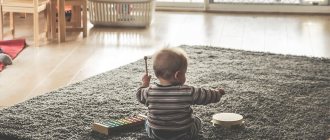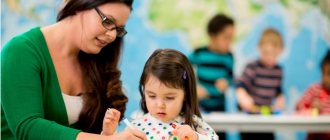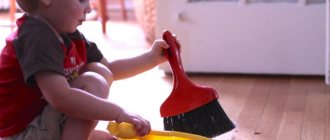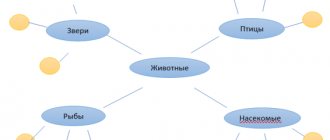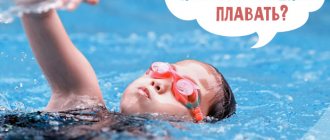The concept of teaching methods and techniques
Definition 2
Teaching method is a way of organized and orderly activities of the teacher and children, aimed at achieving the goals and objectives of education in the learning process.
Quite often the concept of method is identified with the concept of technique. However, these are different concepts in content and definition.
Definition 3
A technique is a part of a method, which is its specific element.
Are you an expert in this subject area? We invite you to become the author of the Directory Working Conditions
Teaching methods involve interrelated activities of the teacher and students, the direction of which depends on the educational goal. In this connection, each teaching method organically includes the educational activities of the teacher and the active educational and cognitive activity of children.
The activity of children, within the framework of the teaching method, is active and purposeful work on the perception and assimilation of educational material provided by the teacher.
The activities of the teacher, within the framework of the teaching method - presentation of educational material, explanation, organization of training sessions, etc.
Quite often, the role of the teacher in the educational process comes down to the fact that he defines the topic, conducts an introductory conversation, gives instructions for carrying out independent educational work, and only after that invites the children to comprehend and assimilate the educational material.
Thus, the nature of the teacher’s activity depends on which teaching method he chose to master a specific educational topic. However, despite the type of method, a prerequisite is the orderly and organized activity of the teacher and children.
Finished works on a similar topic
Course work Practical methods of teaching preschoolers 420 ₽ Abstract Practical methods of teaching preschoolers 280 ₽ Test paper Practical methods of teaching preschoolers 240 ₽
Receive completed work or specialist advice on your educational project Find out the cost
Note 1
So, teaching methods mean all the methods of a teacher’s teaching work and the organization of educational and cognitive activities of children, aimed at solving didactic problems and mastering new educational material.
Selection of teaching methods
The choice of teaching method for preschool children is most often made by the teacher in any form. When choosing a method, the teacher takes into account a number of factors, such as:
- Educational goals facing a preschool institution, based on the state standard and the guidelines of modern didactics.
- Taking into account the peculiarities of the content of the science or subject being studied.
- Features of the teaching methodology of a specific academic discipline, due to its specifics.
- Purpose, objectives and content of educational material for a specific age level.
- Taking into account the characteristics and individualities of children, their age-related capabilities and needs.
- Level of readiness of children. They take into account the level of education, development and knowledge.
- Material and technical capabilities of the children's educational institution, the availability of the necessary visuals, methodological and teaching aids, and technical means.
- The capabilities and characteristics of the teacher, the level of theoretical and practical preparedness, methodological skills, and his personal qualities.
Get paid for your student work
Coursework, abstracts or other works
Teaching methods in preschool educational institutions
Training is carried out using various methods. Translated from Greek, “method” means a path to something, a way to achieve a goal.
A teaching method is a system of consistent interconnected ways of working between the teacher and the children being taught, which are aimed at achieving a didactic goal.
This definition of the method emphasizes the two-way nature of the learning process. Teaching methods are not limited to the activities of the teacher, but assume that he, using special methods, stimulates and directs the cognitive and related practical activities of the children themselves. Thus, we can say that teaching methods reflect the interconnected activities of the teacher and children, subordinated to the solution of the didactic task.
The choice of teaching method depends, first of all, on the purpose and content of the upcoming lesson. When learning to draw, design, and sing, the leading method will be exercise, since without this it is impossible to learn to draw, design, and sing. The exercise method also prevails in physical education classes. In natural history classes, the “first fiddle” is played by methods of observation, conversation, experimentation, etc.
The teacher gives preference to one or another method, based on the equipment of the pedagogical process. If there are few manuals, handouts or demonstration materials in a preschool institution, then it is impossible to use many teaching methods.
The choice of teaching method also depends on the personality of the teacher, on his abilities and responsibility. Different teachers mean different teaching methods, and as a result, results in children’s development that are incomparably effective.
In modern pedagogy there is no single generally accepted classification of teaching methods. In preschool pedagogy, a classification has been adopted, which is based on the basic forms of thinking that determine the nature of the ways in which children act in the learning process. These forms include visual-effective and visual-figurative thinking. In this regard, the main methods of teaching preschoolers are practical, visual, verbal, and play methods. It should be recalled that all these methods in the real learning process are used together, in various combinations with each other, and not in isolation.
Visual methods
Cognitive and practical activities in the classroom can be organized on the basis of a visual display of relevant objects and phenomena. The group of visual teaching methods includes observation, demonstration of visual aids (objects, pictures, filmstrips, slides, videos, computer programs).
Observation is the ability to peer into the phenomena of the surrounding world, highlight the essential, basic in them, notice the changes that occur, establish their causes, and draw conclusions. Direct observation by children of the objects being studied is important for the formation of full-fledged ideas and the development of cognitive processes - perception, memory, thinking, imagination. In the process of observation, a variety of mental activities of the child are carried out: searching for answers to the questions posed, comparison, comparison.
Observations are carried out during special classes (observation of fish, cats and kittens), and on excursions. However, the teacher must be able to use any unplanned situation to organize observations, if it makes it possible to enrich children with vivid ideas and evoke in them a range of feelings (surprise, admiration, enjoyment of beauty, etc.). For example, a flock of bullfinches flew to the site, a rainbow appeared in the sky, workers were repairing the roof of the veranda, etc.
In teaching preschoolers, observation develops in two directions. First of all, the circle of observed objects is gradually expanding: observations in the group room, then in other rooms of the preschool institution, on the site and, finally, outside: in a public garden, in a park, at a school stadium, by the river, at a public transport stop, etc. Concentricity of observation is also observed, when, when familiar with the same objects, children are led from recognizing the object at first acquaintance to identifying significant features, with repeated observations - to comparison with other objects and, finally, to generalization.
In teaching preschoolers, different types of observations are used: short-term and long-term observations, as well as repeated and comparative ones. Long-term observations make it possible to acquaint children with the process of development, with changes in the state of a particular object, which seems to be necessary material for the development of mental activity (comparison, discrimination, identification of essential features, establishment of cause-and-effect relationships). Comparative observations are of particular value for the development of children’s mental activity. Children of middle preschool age are offered two directly observable objects for comparison: a sparrow and a crow, a birch and a spruce. Older preschoolers can compare an observed object with another that is not directly perceived at the moment (comparison by presentation): a bus and a tram, a river and a pond, a newspaper and a letter, a square and a forest.
In preschool pedagogy, didactic requirements for observation as a teaching method have been developed (E.A. Flerina, E.I. Radina, P.G. Samorukova, etc.), namely:
- the object of observation should be interesting for children, since if there is interest, more distinct ideas are formed;
- an object is observed under conditions that allow its characteristic features to be revealed. Therefore, whenever possible, observations should be carried out in a natural setting (it is better to observe a rabbit on the lawn of a kindergarten, and not in a group room, etc.);
- the teacher outlines the purpose of observation, determines the range of new knowledge, and thinks through how to connect it with the experience of children;
- children are given a target setting for observation, which ensures completeness of perception (we will observe the rabbit, then we will draw it, we will come up with a story about it);
- the knowledge acquired in the process of observation, the feelings that have arisen and the attitude towards what is observed should be further developed in the activities of children;
— ensure consistency and orderliness of observation in accordance with the assigned tasks, characteristics of the objects, and the age of the children;
- observation should be accompanied by an exact specific word: name objects, their signs, actions. As the observation progresses, brief explanations should be given; you can refer to a line of a poem, a proverb, or a folk adage. However, the main content of ideas should be formed on the basis of the active cognitive activity of the children themselves.
Demonstration (examination) of paintings, reproductions, filmstrips, slides, videos and other visual aids is an important method of teaching preschoolers, allowing them to solve a number of didactic problems. Visual aids give the child a visual image of familiar and unfamiliar objects. With the help of paintings, pictures, diagrams, children form static visual images. Technical teaching aids (TTA) are used to create dynamic visual images.
Looking at paintings, pictures and other visual aids helps to develop observation skills, mental processes (comparison, discrimination, generalization, analysis), enrich speech, and influence interests. The picture provides food for the child’s imagination and creative activity.
Different types of paintings are used in preschool. First of all, these are specially created didactic paintings, often combined into special series (about the seasons, the animal world, etc.). Reproductions of paintings by famous artists serve to introduce children to culture and art (for example, “Golden Autumn”, “March” by I.I. Levitan, “Ivan Tsarevich on the Gray Wolf”, “Alyonushka” by V.M. Vasnetsov, etc.). Book graphics (illustrations in the book) are also used as a visual teaching aid, with the help of which the heroes of the work come to life, the countries and cities where the events take place appear. In addition, the teacher selects subject pictures, classifies them by topic (“Toys”, “Transport”, “Adult Labor”, “Animals”, “Our City”, etc.), designs and uses them for individual lessons with children, as well as as a handout for group and frontal classes.
For educational purposes, slides, filmstrips, videos are shown in classes, and computer programs are used. content.
It must be taken into account that a simple demonstration of an object, phenomenon, or its image does not yet ensure that the child identifies the necessary aspects and properties of these objects. Spontaneously occurring perception does not lead to the formation of correct ideas about objects. A leading role is required for the teacher who organizes the process of children's perception. Organization consists in the fact that an adult, in strict sequence, identifies various aspects and properties of an object, linking individual knowledge into a holistic idea of the object.
Practical methods
Practical teaching methods are those methods by which the teacher imparts a practical character to the cognitive activity of children, the acquisition of new knowledge and skills. This means that the activity is aimed at the real transformation of things, during which the child learns their properties and connections that are inaccessible to direct perception.
The leading practical teaching methods are exercises, experiments and experimentation, and modeling.
Exercise is the repeated repetition by a child of mental or practical actions of a given content. Thanks to exercises, children master various methods of mental activity, they develop various skills (educational, practical).
Various types of exercises are used in teaching preschoolers. In some cases, children perform exercises imitating the teacher (imitative exercises). Exercises of another type are called constructive, because in them the child implements tasks similar to those that he solved under the guidance of the teacher. In other words, the child transfers previously learned methods of action to new content. And finally, the child performs creative exercises that require combination, a different combination of knowledge and skills that he owns.
Exercises are carried out in a specific system, which is built on the basis of gradually more complex knowledge and skills, and also corresponds to the training program for a specific age group.
The didactic rules for conducting the exercises are as follows:
— set a learning task for the children, tell them what they have to do (we will learn to make clothes for a doll out of paper, write sentences, solve problems, etc.);
show the method of performing actions with simultaneous verbal explanation. In case of difficulties, remind, with the help of a question, focus the children’s attention on the difficult, incomprehensible, sometimes prompt, advise, encourage;
to master knowledge and skills, repeated exercises are required, but with a gradually more complex task;
Children's performance of exercises needs to be supervised by the teacher, otherwise erroneous work methods and distorted knowledge may become entrenched.
Experiences and experimentation. Elementary experiences and experiments that are used in preschool education are aimed at helping the child acquire new knowledge about a particular subject. The activity of experimentation, which is formed in line with the child’s own activity, develops intensively throughout preschool age.
To assimilate certain signs and properties of objects, the child’s search actions aimed at a specific result are effective. Identification of hidden signs is carried out using elementary experiments. During their course, the teacher, together with the children, creates special conditions that help determine one or another hidden sign. These are the experiments of turning water into steam, snow into water; experiments with sand and clay, with wax. Experiments help children to better understand the phenomena that occur in the world around them and to find out the connections between them.
Modeling is a visual and practical teaching method. The model is a generalized image of the essential properties of the modeled object (room plan, geographical map, globe, etc.).
The modeling method is that a child’s thinking is developed with the help of special schemes, models that reproduce the hidden properties and connections of a particular object in a visual and accessible form.
The modeling method is based on the principle of substitution: a child replaces a real object with another object, its image, or some conventional sign. Initially, the ability for substitution is formed in children in the game (a pebble becomes candy, sand becomes porridge for a doll, and he himself becomes a dad, driver, astronaut).
Different types of models are used in preschool education. First of all, subject ones, in which the design features, proportions, and interrelationships of parts of any objects are reproduced. Older preschoolers have access to subject-schematic models in which essential features and connections are expressed using substitute objects and graphic signs.
Game methods.
The advantage of game-based teaching methods is that they arouse increased interest and positive emotions in children, and help to concentrate attention on the learning task, which becomes not imposed from the outside, but a desired, personal goal. Solving an educational task during the game involves less expenditure of nervous energy and minimal volitional efforts.
Modern research has revealed that these methods make it possible to direct not only the mental activity of children, but also motor activity. Motor activity contributes to the formation of rich associative connections, which facilitates the acquisition of knowledge and skills. In a game situation, perception processes occur in the child’s mind more quickly and accurately.
Gaming methods are characterized by a number of features. First of all, they transfer the educational action to a conditional plan, which is set by the corresponding system of rules or scenario. Another feature is that the child is required to fully engage in the game situation. Consequently, the teacher must play with children and refuse direct educational influence, comments, and reproaches.
Game methods are quite varied. The most common is a didactic game. It has two functions in the learning process. The first function is to improve and consolidate knowledge. At the same time, the child does not simply reproduce knowledge in the form in which it was learned, but transforms, transforms it, learns to operate with it depending on the game situation. The essence of the second function of the didactic game is that children acquire new knowledge and skills of different content.
Types of practical methods of teaching preschoolers
The following types of teaching methods for preschoolers are distinguished:
- Visual methods: observation, demonstration of visual aids.
- Verbal methods: story (teacher or children), conversation, reading fiction.
- Game methods: didactic game, imaginary situations with roles.
- Practical methods: exercises, elementary experiments, experimentation, modeling.
Practical methods of teaching preschoolers are methods aimed at organizing the cognitive activity of preschool children, with the aim of assimilating new knowledge and skills of a practical nature.
The leading practical methods of teaching preschoolers are:
- Exercise
- Elementary experiments and experiments
- Modeling
Exercise is the repeated repetition by a child of mental or practical actions in order to consolidate them and bring them to a state of skill. In the process of performing exercises, children are given the opportunity to master various methods of mental activity and develop educational and practical skills. With the help of exercises, a child can master most of the content of preschool learning.
Elementary experiments and experiences are aimed at a preschool child acquiring new knowledge about a certain object, phenomenon or action. During the experiment, the child influences the object of cognition in order to establish its properties, connections, etc. If an object has any hidden properties, then their identification is carried out through the organization of elementary experiments.
Experimentation, as an activity of a preschool child, is formed and developed in line with his own activity throughout preschool childhood.
Experiments and experimentation are aimed at developing such qualities and skills as observation, the ability to compare, contrast, express one’s opinion in a reasoned manner, and formulate conclusions.
Modeling is a visual and practical teaching method that involves creating a model that includes generalized images of the main properties of the modeled object.
The basis of the modeling method is the replacement of a real object with its model (image, layout, symbol, etc.).
Initially, the ability to model (substitute) is formed in children during play, when they replace real objects with toys or even make a conventional designation (for example, a stick is a spoon, a leaf of a tree is money, pebbles are candies for a doll, etc. ).
In addition, the experience of modeling (substitution) accumulates in the process of the child mastering speech and visual activity. For example, when mastering speech, the teacher uses colors for sound analysis: vowels - red, consonants - blue, which contributes not only to the acquisition of the sound basis of the word, but also to the accumulation of modeling experience.
